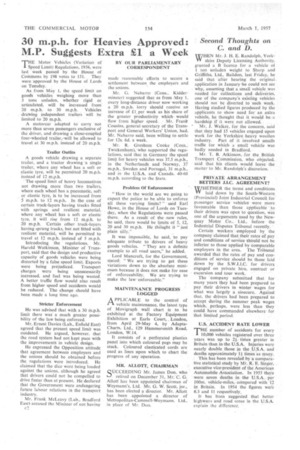• Second Thoughts on C. and D.
Page 44

If you've noticed an error in this article please click here to report it so we can fix it.
WIHEN Mr. I. H. E. Randolph, YorkVV shire Deputy Licensing Authority, granted a II licence for a vehicle of 1 ton unladen weight to Sharp and Griffiths, Ltd., Baildon, last Friday, he said that after hearing the original, application in laauary 'he could not see why, assuming that a small vehicle was needed for collections and deliveries, one of the company's existing vehicles should not be diverted to such work. Having studied figures produced by the applicants to show need for an extra vehicle, he thought that it would be .3 hardship if it were not allowed, -•
Mr. J. Walker, for the concern, said that they had 15 vehicles engaged upon work for the Yorkshire heavy woollen industry. Part of it involved smalls traffic for which a small vehicle was badly needed in Bradford.
Mr. T. B. Atkinson, for the British Transport Commission, who objected, said that his clients would leave the matter to Mr. Randolph's discretion.
PRIVATE ARRANGEMENT BETTERS J.I.C. AGREEMENT?
WHETHER the terms and conditions laid down by the South-Western. (Provincial) Joint Industrial Council for passenger service vehicles. were more favourable than those applicable to. their drivers was open to question, was one of the arguments used by the Newquay Motor CD., Ltd., before the Industrial Disputes Tribunal recently.
Certain workers employed by the company claimed that their rates of pay and conditions of service should not be inferior to those applied by comparable employers in the area. The Tribunal awarded that the rates of pay and conditions of service should be those laid down by the S.W.J.1.C. for drivers engaged on private hire, contractor excursion and tour work.
The *company submitted that for many years they had been prepared to pay their drivers in winter wages for what was largely a sinecure. Against that, the drivers had been prepared to accept during the summer peak wages which, perhaps, were less than they could have commanded elsewhere for that limited ,period.
U.S. ACCIDENT RATE LOWER THE number of accidents for every 10,000 vehicles registered over three years was up to 21 times greater in Britain than in the U.S.A. Injuries were nearly double those in the U.S.A. and deaths approximately 1+ times as many.
This has been revealed by a comparative statistical study by Mr.A. E. Singer, executive vice-president of the American Automobile Association, In 1953 there were seven deaths in the U.S.A. per 1(10m. vehicle-miles, compared with 12 in Britain. In 1954 the figures were 6.3 and 11 respectively.
It has been suggested that better highways and road sense in the U.S.A. explain the difference.












































































































